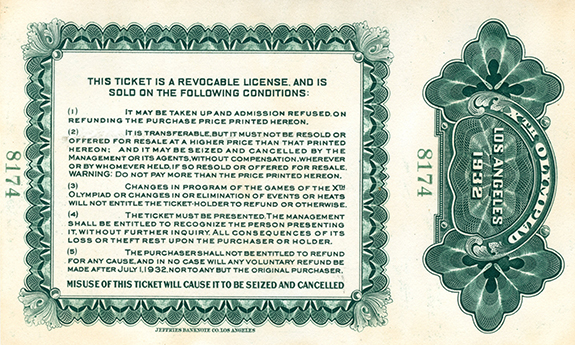The Los Angeles Olympics of 1932

This is a scan of the ticket of Will H. Hays, Jr. to the 1932 Los Angeles Olympics. It is housed in a leatherette case and is printed on thick card stock by the Jeffries Banknote Company of Los Angeles. And looking at it, we can clearly see the similarities between this ticket and banknotes of that era.
Here is a closeup of the ticket.

Here we can clearly see the intricate borders and in the background a rendering of the Rose Bowl Stadium [correction courtesy of Joe Day – this is the Los Angeles Memorial Coliseum] where much of the games took place. And from the seat listed it looks like young Bill Hays had a really great view of the festivities.
Bill Hays [Wabash class of 1937] was the son of Will H. Hays, Sr. [Wabash class of 1900] who was known at this time as the “Movie Czar” and spent a great deal of his time in Hollywood. Naturally, the Olympics were a huge event in the life of Southern California in 1932. This ticket, with a face value of $22 would have been quite a stretch for most Americans in 1932 during the Great Depression. A quick check of the average wage for workers in 1932 shows that the average rate was 45.8 cents per hour.* That was assuming, of course, that one could find work in that time. A rough calculation shows that it would have taken six full workdays to pay the face value. Or a family’s entire paycheck for one week to purchase a ticket for just one person. So it would have been a real treat for those who could afford it.

This is the back of the ticket and spells out the limitations on the purchaser. No scalping, no refunds for events cancelled, in general no refunds of any sort, no liability for lost or stolen tickets and all spectators must present a ticket to enter.
From the Library of Congress website** we can read more about these historic games:
On July 30, 1932, United States Vice President Charles Curtis declared, “I proclaim open the Olympic Games of Los Angeles, celebrating the tenth Olympiad of the modern era.” A crowd of 100,000 spectators watched as some 1,332 athletes, representing 37 nations, paraded into the stadium. Vice President Curtis pressed a silver button to light the Olympic torch, the Olympic flag was raised, and 2,000 pigeons were released.
I was also quite interested to read that the LA Olympics of 1932 sported the first ever Olympic Village. Here is more from the Library of Congress site:
The Olympic Village was first instituted at the 1932 Olympics to counteract the effects of the Great Depression and to provide an affordable and convenient place for athletes and officials to eat and be housed.
Among the United States athletes on the field were Mildred (Babe) Didrikson, Ralph Harold Metcalfe, Edward (Eddie) Thomas Tolan, Helene Madison, and Benjamin (Ben) B. Eastman. Eighteen-year-old track competitor Babe Didrikson won two gold medals and one silver medal. Jim Thorpe, who had won gold in the 1912 games, watched from the presidential box. He was unable to purchase regular tickets because of the personal financial ruin that befell him during the Great Depression.
It must have been so exciting for those who watched in person. Although the games were not televised, some events were broadcast over the radio, using “a word picture of the…events” so that America could cheer on her heroes. The Olympics still have the power to inspire folks around the world.
Here are links to the sources used.
*https://fraser.stlouisfed.org/files/docs/publications/bls/he_bls_1942.pdf
**https://www.loc.gov/item/today-in-history/july-30?loclr=eatod
All best,
Beth Swift
Archivist
Wabash College
Crawfordsville, Indiana